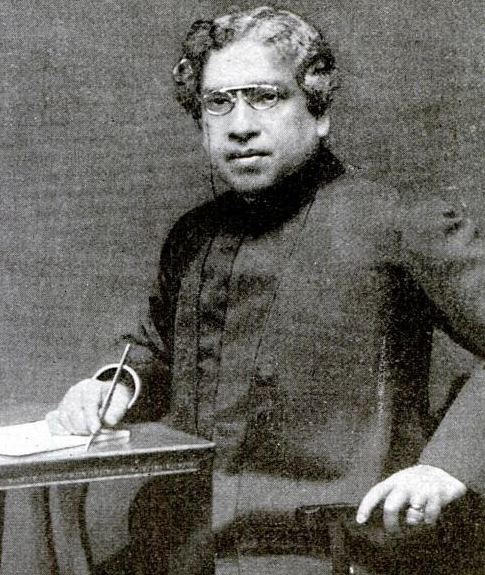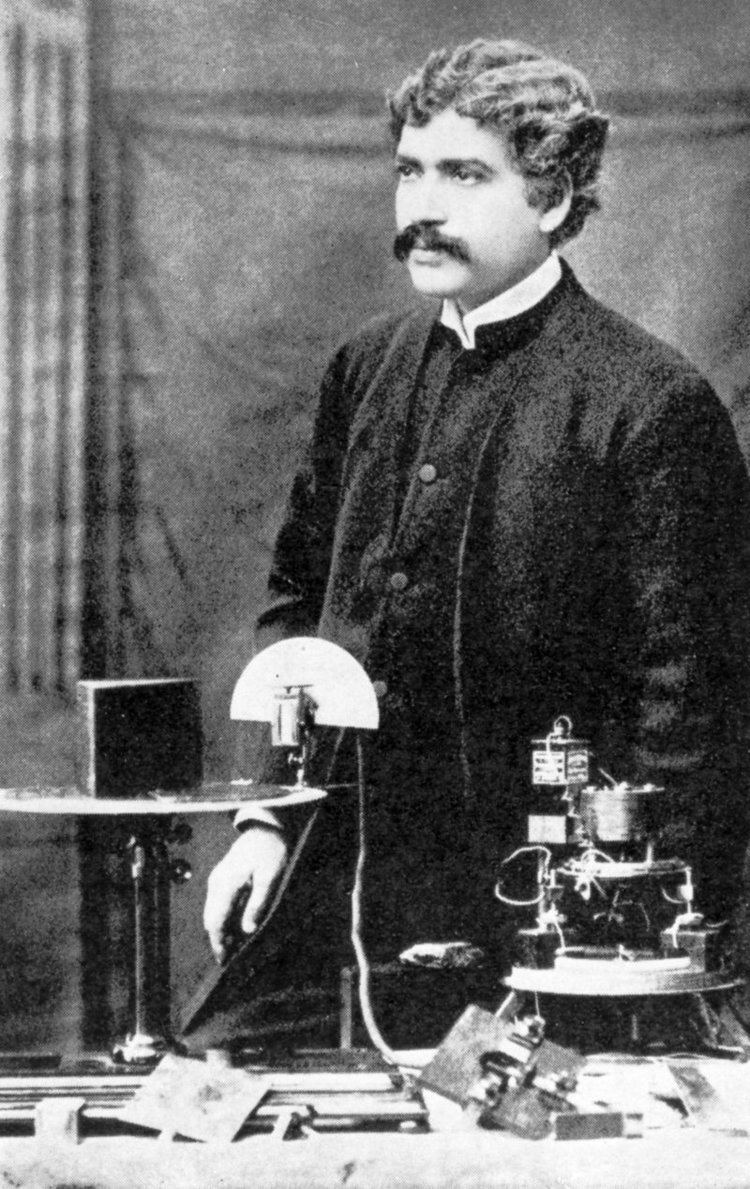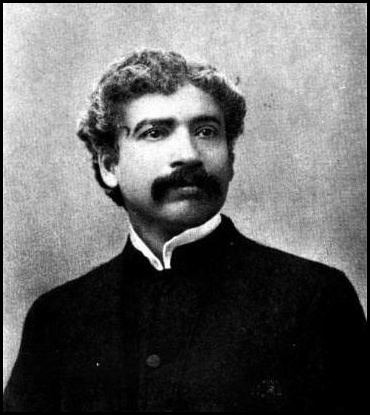Name Jagadish Bose | ||
 | ||
Fields Alma mater University of CalcuttaChrist's College, Cambridge Books Response in the Living and Non-living, Sir Jagadis Chunder Bose His Life and Speeches Parents Bhagawan Chandra Bose, Bama Sundari Bose Similar People Satyendra Nath Bose, Prafulla Chandra Ray, Meghnad Saha, C V Raman, Homi J Bhabha | ||
Academic advisors John Strutt (Rayleigh) | ||
Mars beyond jagadish chandra bose the first modern indian scientist
Sir Jagadish Chandra Bose, CSI, CIE, FRS (; [dʒɔgod̪iʃ tʃɔnd̪ro bosu]; 30 November 1858 – 23 November 1937), also spelled Jagdish and Jagadis, was a Bengali polymath, physicist, biologist, biophysicist, botanist and archaeologist, and an early writer of science fiction. Living in British India, he pioneered the investigation of Radio and microwave optics, made significant contributions to plant science, and laid the foundations of experimental science in the Indian subcontinent. IEEE named him one of the fathers of radio science. Bose is considered the father of Bengali science fiction, and also invented the crescograph, a device for measuring the growth of plants. A crater on the moon has been named in his honour.
Contents
- Mars beyond jagadish chandra bose the first modern indian scientist
- Sir jagadish chandra bose biography in tamil
- Early life and education
- Radio research
- Place in radio development
- Plant research
- Study of metal fatigue and cell response
- Science fiction
- Legacy
- Honours
- Publications
- References

Born in Munshiganj, Bengal Presidency during the British Raj (present-day Bangladesh), Bose graduated from St. Xavier's College, Calcutta. He went to the University of London to study medicine, but could not pursue studies in medicine because of health problems. Instead, he conducted his research with the Nobel Laureate Lord Rayleigh at Cambridge and returned to India. He joined the Presidency College of the University of Calcutta as a professor of physics. There, despite racial discrimination and a lack of funding and equipment, Bose carried on his scientific research. He made remarkable progress in his research of remote wireless signalling and was the first to use semiconductor junctions to detect radio signals. However, instead of trying to gain commercial benefit from this invention, Bose made his inventions public in order to allow others to further develop his research.

Bose subsequently made a number of pioneering discoveries in plant physiology. He used his own invention, the crescograph, to measure plant response to various stimuli, and thereby scientifically proved parallelism between animal and plant tissues. Although Bose filed for a patent for one of his inventions because of peer pressure, his objections to any form of patenting was well known. To facilitate his research, he constructed automatic recorders capable of registering extremely slight movements; these instruments produced some striking results, such as quivering of injured plants, which Bose interpreted as a power of feeling in plants. His books include Response in the Living and Non-Living (1902) and The Nervous Mechanism of Plants (1926).
Sir jagadish chandra bose biography in tamil
Early life and education

Sir Jagadish Chandra Bose was born in Munshiganj, Bengal Presidency, (present-day Bangladesh) on 30 November 1858. His father, Bhagawan Chandra Bose, was a leading member of the Brahmo Samaj and worked as a deputy magistrate and assistant commissioner in Faridpur, Bardhaman and other places.
Bose's education started in a vernacular school, because his father believed that one must know one's own mother tongue before beginning English, and that one should know also one's own people. Speaking at the Bikrampur Conference in 1915, Bose said:
At that time, sending children to English schools was an aristocratic status symbol. In the vernacular school, to which I was sent, the son of the Muslim attendant of my father sat on my right side, and the son of a fisherman sat on my left. They were my playmates. I listened spellbound to their stories of birds, animals and aquatic creatures. Perhaps these stories created in my mind a keen interest in investigating the workings of Nature. When I returned home from school accompanied by my school fellows, my mother welcomed and fed all of us without discrimination. Although she was an orthodox old-fashioned lady, she never considered herself guilty of impiety by treating these ‘untouchables’ as her own children. It was because of my childhood friendship with them that I could never feel that there were ‘creatures’ who might be labelled 'low-caste'. I never realised that there existed a 'problem' common to the two communities, Hindus and Muslims.
Bose joined the Hare School in 1869 and then St. Xavier's School at Kolkata. In 1875, he passed the Entrance Examination (equivalent to school graduation) of the University of Calcutta and was admitted to St. Xavier's College, Calcutta. At St. Xavier's, Bose came in contact with Jesuit Father Eugene Lafont, who played a significant role in developing his interest in natural sciences. He received a BA from the University of Calcutta in 1879.
Bose wanted to go to England to compete for the Indian Civil Service. However, his father, a civil servant himself, cancelled the plan. He wished his son to be a scholar, who would “rule nobody but himself.” Bose went to England to study Medicine at the University of London. However, he had to quit because of ill health. The odour in the dissection rooms is also said to have exacerbated his illness.
Through the recommendation of Anandamohan Bose, his brother-in-law (sister's husband) and the first Indian wrangler, he secured admission in Christ's College, Cambridge to study natural sciences. He received a BA (Natural Sciences Tripos) from the University of Cambridge and a BSc from the University of London in 1884, and a DSc from the University of London in 1896. Among Bose's teachers at Cambridge were Lord Rayleigh, Michael Foster, James Dewar, Francis Darwin, Francis Balfour, and Sidney Vines. At the time when Bose was a student at Cambridge, Prafulla Chandra Roy was a student at Edinburgh. They met in London and became intimate friends. Later he was married to Abala Bose, the renowned feminist and social worker.
Radio research
The Scottish theoretical physicist James Clerk Maxwell mathematically predicted the existence of electromagnetic radiation of diverse wavelengths, but he died in 1879 before his prediction was experimentally verified. Between 1886 and 1888, German physicist Heinrich Hertz published the results of his experiments on electromagnetism, which showed the existence of electromagnetic waves in free space. Subsequently, British physicist Oliver Lodge, who had also been researching electromagnetism, conducted a commemorative lecture in August 1894 (after Hertz's death) on the quasi-optical nature of "Hertzian waves" (radio waves) and demonstrated their similarity to light and vision including reflection and transmission at distances up to 50 metres. Lodge's work was published in book form and caught the attention of scientists in different countries, including Bose in India.
The first remarkable aspect of Bose's follow-up microwave research was that he reduced the waves to the millimetre level (about 5 mm wavelength). He realised the disadvantages of long waves for studying their light-like properties.
During a November 1894 (or 1895) public demonstration at Town Hall of Kolkata, Bose ignited gunpowder and rang a bell at a distance using millimetre range wavelength microwaves. Lieutenant Governor Sir William Mackenzie witnessed Bose's demonstration in the Kolkata Town Hall. Bose wrote in a Bengali essay, Adrisya Alok (Invisible Light), "The invisible light can easily pass through brick walls, buildings etc. Therefore, messages can be transmitted by means of it without the mediation of wires."
Bose's first scientific paper, "On polarisation of electric rays by double-refracting crystals" was communicated to the Asiatic Society of Bengal in May 1895, within a year of Lodge's paper. His second paper was communicated to the Royal Society of London by Lord Rayleigh in October 1895. In December 1895, the London journalElectrician (Vol. 36) published Bose's paper, "On a new electro-polariscope". At that time, the word coherer, coined by Lodge, was used in the English-speaking world for Hertzian wave receivers or detectors. The Electrician readily commented on Bose's coherer. (December 1895). The Englishman (18 January 1896) quoted from the Electrician and commented as follows:
Should Professor Bose succeed in perfecting and patenting his ‘Coherer’, we may in time see the whole system of coast lighting throughout the navigable world revolutionised by a Bengali scientist working single handed in our Presidency College Laboratory.
Bose planned to "perfect his coherer" but never thought of patenting it.
Bose went to London on a lecture tour in 1896 and met Italian inventor Guglielmo Marconi, who had been developing a radio wave wireless telegraphy system for over a year and was trying to market it to the British post service. In an interview, Bose expressed his disinterest in commercial telegraphy and suggested others use his research work. In 1899, Bose announced the development of a "iron-mercury-iron coherer with telephone detector" in a paper presented at the Royal Society, London.
Place in radio development
Bose' work in radio microwave optics was specifically directed towards studying the nature of the phenomenon and was not an attempt to develop radio into a communication medium. His experiments took place during this same period (from late 1894 on) when Guglielmo Marconi was making breakthroughs on a radio system specifically designed for wireless telegraphy and others were finding practical applications for radio waves, such as Russian physicist Alexander Stepanovich Popov radio wave base lightning detector, also inspired by Lodge's experiment. Although Bose's work was not related to communication he, like Lodge and other laboratory experimenters, probably had an influence on other inventors trying to develop radio as communications medium. Bose was not interested in patenting his work and openly revealed the operation of his galena crystal detector in his lectures. A friend in the US persuaded him to take out a US patent on his detector but he did not actively pursue it and allowed it to lapse."
Bose was the first to use a semiconductor junction to detect radio waves, and he invented various now-commonplace microwave components. In 1954, Pearson and Brattain gave priority to Bose for the use of a semi-conducting crystal as a detector of radio waves. In fact, further work at millimetre wavelengths was almost non-existent for the following 50 years. In 1897, Bose described to the Royal Institution in London his research carried out in Kolkata at millimetre wavelengths. He used waveguides, horn antennas, dielectric lenses, various polarisers and even semiconductors at frequencies as high as 60 GHz;. Much of his original equipment is still in existence, especially at the Bose Institute in Kolkata. A 1.3 mm multi-beam receiver now in use on the NRAO 12 Metre Telescope, Arizona, US, incorporates concepts from his original 1897 papers.
Sir Nevill Mott, Nobel Laureate in 1977 for his own contributions to solid-state electronics, remarked that "J.C. Bose was at least 60 years ahead of his time. In fact, he had anticipated the existence of P-type and N-type semiconductors."
Plant research
His major contribution in the field of biophysics was the demonstration of the electrical nature of the conduction of various stimuli (e.g., wounds, chemical agents) in plants, which were earlier thought to be of a chemical nature. These claims were later proven experimentally. He was also the first to study the action of microwaves in plant tissues and corresponding changes in the cell membrane potential. He researched the mechanism of the seasonal effect on plants, the effect of chemical inhibitors on plant stimuli and the effect of temperature. From the analysis of the variation of the cell membrane potential of plants under different circumstances, he hypothesised that plants can "feel pain, understand affection etc."
Study of metal fatigue and cell response
Bose performed a comparative study of the fatigue response of various metals and organic tissue in plants. He subjected metals to a combination of mechanical, thermal, chemical, and electrical stimuli and noted the similarities between metals and cells. Bose's experiments demonstrated a cyclical fatigue response in both stimulated cells and metals, as well as a distinctive cyclical fatigue and recovery response across multiple types of stimuli in both living cells and metals.
Bose documented a characteristic electrical response curve of plant cells to electrical stimulus, as well as the decrease and eventual absence of this response in plants treated with anaesthetics or poison. The response was also absent in zinc treated with oxalic acid. He noted a similarity in reduction of elasticity between cooled metal wires and organic cells, as well as an impact on the recovery cycle period of the metal.
Science fiction
In 1896, Bose wrote Niruddesher Kahini (The Story of the Missing One), a short story that was later expanded and added to Abyakta (অব্যক্ত) collection in 1921 with the new title Palatak Tuphan (Runaway Cyclone). It was one of the first works of Bengali science fiction. It has been translated into English by Bodhisattva Chattopadhyay.
Legacy
Bose's place in history has now been re-evaluated. His work may have contributed to the development of radio communication. He is also credited with discovering millimetre length electromagnetic waves and being a pioneer in the field of biophysics.
Many of his instruments are still on display and remain largely usable now, over 100 years later. They include various antennas, polarisers, and waveguides, which remain in use in modern forms today.
To commemorate his birth centenary in 1958, the JBNSTS scholarship programme was started in West Bengal. In the same year, India issued a postage stamp bearing his portrait.
On 14 September 2012, Bose's experimental work in millimetre-band radio was recognised as an IEEE Milestone in Electrical and Computer Engineering, the first such recognition of a discovery in India.
On 30 November 2016, Bose was celebrated in a Google Doodle on the 158th anniversary of his birth.
